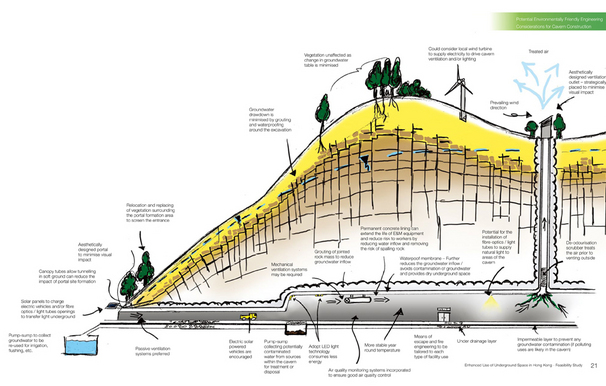Out of Space, Hong Kong Considers Expanding Underground

When a dense city runs out of space on land, maybe it's time to go underground. City dwellers might even appreciate hiding away their trash and sewage plants. If so, Hong Kong residents might be among the first to benefit from the idea of building some portions of a city in underground caves. In March 2011, consulting firm Arup finished a government-commissioned study of the feasibility of relocating power stations, fresh water reservoirs, a trash transfer station and more into vast caverns drilled deep underneath the city. The Geotechnical Engineering Office started gathering public input on the project in November.
"Hong Kong needs to create land resources to cope with the demand for housing and development of various industries. However, our land is limited," Donald Tsang, Hong Kong's chief executive, said in a press release. "Reclamation outside Victoria Harbour and rock cavern development are options worth considering."
The underground option would be especially appealing for "Not In My Back Yard or Bad Neighbor type facilities," such as sewage plants, geologists wrote in their feasibility report. By hiding away plants such as the Sha Tin Sewage Treatment Works, which now sits on waterfront property, the Hong Kong government would free prime land and improve property values for the people who already live there. But researchers also ranked national archives, parking lots, bicycle park-and-rides and maintenance depots as facilities that should be among the first to move down under.
About 64 percent of Hong Kong's land area has strong enough bedrock to support caverns, the study found. They made a color-coded map of the city, showing the best sites for caverns. "Geological conditions in Hong Kong are generally favourable for the construction of rock caverns," Hong Kong geologists wrote in a paper published in 1997. "The dominant Mesozoic volcanic and granitic rocks are generally very strong and have few major structural weaknesses."
This is not the first time the Fragrant Harbor has considered expanding under the Earth. The city already houses the Stanley Sewage Treatment Works, the Kau Shat Wan Explosives Depot and a few other facilities underground. The city has long worried about a lack of aboveground land and its Geotechnical Engineering Office carried out its first study of the city's underground potential in 1988.
Though Hong Kong is among the first cities in the world to expand underneath the Earth, it had a few examples around the world to look to for inspiration. The city's Secretary for Development visited Norway and Finland in 2010 to talk with agencies that run underground sewage treatment, water treatment, heating and cooling plants in those countries. They also visited Oslo's National Archives, held in four-storey underground buildings, and Oslo's Holmlia Sports Hall, which has a swimming pool, ball courts and fitness machines "and can house 7,000 persons as a civil defence shelter," according to the study.
While the government doesn't have immediate plans to expand its presence into its rocky hillsides, the feasibility study recommends they create some. It also recommends incentives for private companies to partner with the government under the Earth. "Hong Kong should create an environment in which the cavern development option is not overlooked or treated as unconventional," they wrote.
Get the world’s most fascinating discoveries delivered straight to your inbox.
This story was provided by InnovationNewsDaily, a sister site to LiveScience. Follow InnovationNewsDaily on Twitter @News_Innovation, or on Facebook.
 Live Science Plus
Live Science Plus






